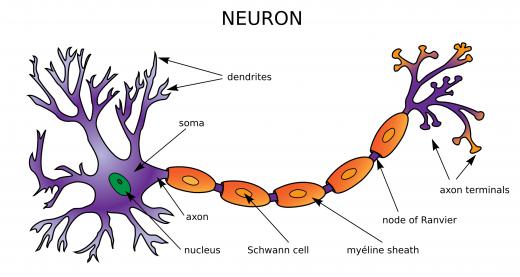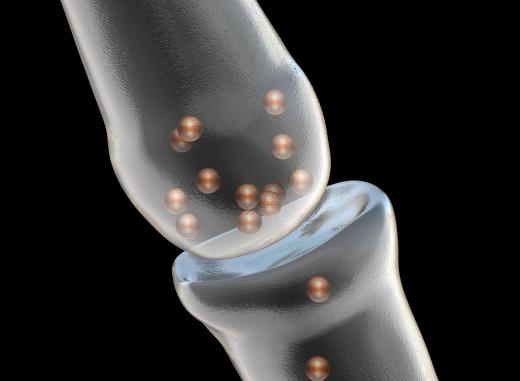What is Neural Plasticity?
Neural plasticity, also known as neuroplasticity and by a variety of other names, is the changing of the structure, function and organization of neurons, or nerve cells, in response to new experiences. It specifically refers to strengthening or weakening nerve connections or adding new nerve cells based on outside stimuli. These processes are responsible for learning, the formation of appropriate responses to external events and, in some cases, recovery from brain injury. Neural plasticity is among the most important aspects of the field of modern neuroscience and its study is leading to a better understanding of brain development, learning and the rehabilitation of brain-injured patients, among other things.
Mechanisms

Neurons consist of a cell body, with one or more branched structures known as dendrites and a long, fiber-like extension, known as an axon. Dendrites mainly receive signals from sensory organs and other neurons. The axon sends signals to the dendrites of neighboring nerve cells via tiny gaps called synapses. Communication across these gaps is enabled by chemicals called neurotransmitters. There are three broad mechanisms by which neural plasticity can occur.

Anatomical changes involve physical alterations to neurons, such as axonal sprouting, where axons produce new nerve endings that connect to other pathways in the nervous system. This can strengthen existing connections or help repair parts of the nervous system by restoring damaged neural pathways to full functionality. Neurochemical changes can involve, for example, increasing or decreasing the production of neurotransmitters. Metabolic changes might involve fluctuations in the rates at which nutrients are consumed by parts of the brain.

Plasticity can also involve the removal of connections. Old neural pathways that have not been used for some time can die off. This process is known as synaptic pruning and enables neural connections that no longer serve any purpose to be removed, while more useful ones are strengthened.
Memory, Development and Learning
Neural plasticity is crucial to the development of the brain, the formation of memories and the ability to learn from experience. The brain needs the capacity to change and reorganize itself in order to store information and to arrive at the best responses to outside events. Particularly in the very early years, this involves the formation of many new connections and pathways. In a newborn baby, there are around 2,500 synapses for each neuron in the cerebral cortex, the outermost layer of the brain. During the first two to three years of life, this increases dramatically to about 15,000, but by adulthood, the number has decreased to about half that amount due to synaptic pruning, as unused pathways are removed.

Throughout life, the connections between the axons that send signals and the dendrites that receive them are being strengthened and weakened. If a particular connection is being used a lot, it will be strengthened. Possibly the surface area of the dendrite will be increased or more neurotransmitters will be produced. Conversely, if a connection is not used much, it may be weakened. In this way, the most important pathways are boosted.

It was once believed that neural plasticity only existed in very young individuals and that once neural pathways were formed, they were set and could not be altered. Modern brain study, however, has revealed that nerves continually rearrange themselves throughout the course of life. This is what makes humans able to adapt to a broad range of circumstances; the very physiology of the brain changes in response to experiences. New connections can form at any stage in life, in parallel with the pruning away of old, unused ones, enabling people to gain knowledge and pick up new skills even at an advanced age.
Recovery from Damage and Medical Applications
Because of the ability of nerve cells to restructure and reorganize themselves, damage to the brain or other aspects of the nervous system is not always permanent. Areas of healthy neurons can sometimes take over the functions of damaged parts. In this way, victims of brain injury or stroke have, in some cases, been able to recover at least part of the lost functionality.
As of 2013, a great deal of research is focusing on using neural plasticity for medical purposes. There are many different diseases of the brain and nerves that greatly impair the cognition, memory, mobility or other faculties of those who suffer from them. The partial natural recoveries experienced by some stroke and brain injury victims could possibly be extended and improved by medical intervention to guide the reorganization of neurons. Cerebral palsy and Alzheimer's disease are examples of brain disorders that could potentially be treated through guided neural plasticity. One possible area of future development is the use of neural stem cells to generate new nerve cells and pathways, a technique that might lead to successful treatments for a variety of brain disorders and injuries.
AS FEATURED ON:
AS FEATURED ON:















Discussion Comments
I have been doing cognitive behavioral therapy due to the loss of cognitive functioning. I have M.S. I was diagnosed at the age of 56. I had to leave my job, and get disability. For over 30 years, I did behavioral therapy with the autistic spectrum disorder children. My role as a speech therapist prepared me for my cognitive decline. I wrote out current functioning levels for myself, and generated goals based on formal testing.
I am one of the lucky ones. About 50 to 60 percent of patients with M.S. have cognitive deficits. This therapeutic technique is not being used with patients. Why?
This is indeed a fascinating topic -- my sister is actually really into learning about stuff like this, so I kind of pick some up about it just talking to her. As I understand it, neural plasticity research has various strands.
The article mentions brain disease and brain damage as potential areas for success with this approach. According to my sister, there are also studies looking at how to bypass pain receptors, invaluable for people with chronic conditions such as arthritis.
This evidence that the brain can change and grow beyond childhood may also encourage people of all ages to return to learning. The maxim 'use it or lose it' is likely to become 'use it and you will be able to use it some more'!
Neural plasticity theory is one of the most thrilling developments in modern day science. It's truly amazing to think about what the human brain is capable of.
Post your comments